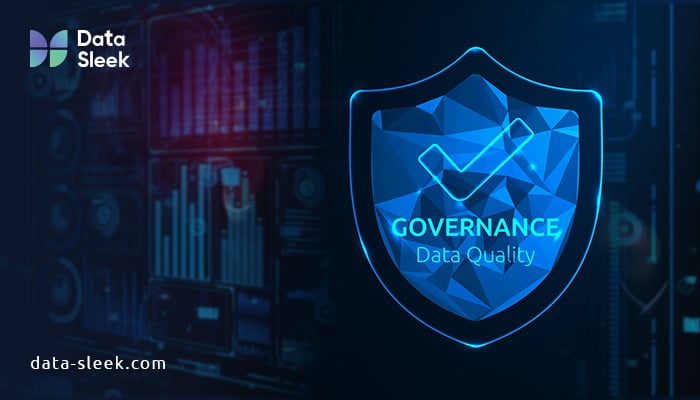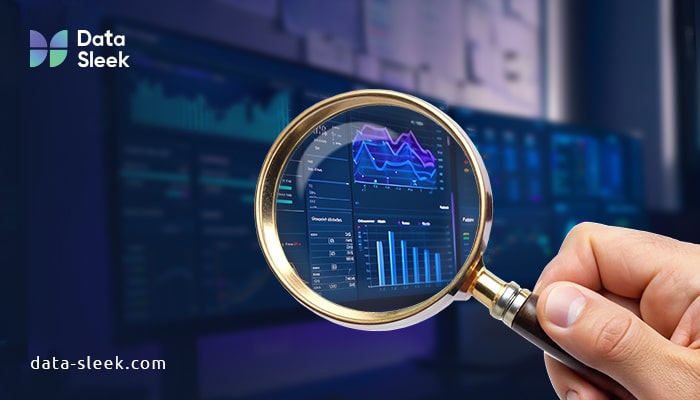Key Highlights
- Data strategy is more than just managing data—it’s a holistic business approach focused on driving value, agility, and growth.
- Investing in advanced tools like Snowflake or Looker doesn’t guarantee a company is “data-driven” without an overarching strategy.
- A solid data strategy aligns technology, processes, and people to business goals, driving informed, timely decisions.
- Key elements include business alignment, governance, defined use cases, maturity modeling, and enablement.
- Effective data strategy enhances ROI, speeds up decisions, ensures compliance, and cultivates a data-first culture.
What Is Data Strategy?
A data strategy is a long-term, organization-wide plan that defines how a business will use its data to provide business value. It aligns technology, people, and processes to turn raw data into actionable insights that drive better decision-making, innovation, and competitive advantage.
Data Management Isn’t the Strategy
Many businesses think data management is the same as having a good data strategy. However, there is a significant difference. Data management focuses on organizing and accessing data. In contrast, a real business strategy uses data to create valuable insights that help reach company goals. The organization may waste time and miss opportunities if it does not connect its data efforts to business goals. Data can only improve decision-making and create lasting value when used purposefully within a business strategy.

Many companies today think having Snowflake, Looker, or dbt means they’re “data-driven.”
Many believe that simply installing the latest data warehouse, BI tool, or transformation platform will make their organization “data-driven.” Companies often think that using advanced tools like Snowflake, Looker, or dbt will bring great results on their own. But using these tools without a clear plan can lead to problems. Teams may struggle with numbers, face inconsistent reports, or get lost in dashboards that don’t meet business needs. Without a clear direction, even the best data management systems can become costly and rarely used.
Real data-driven companies do more than just use tools. They create processes and a company culture that encourages asking better questions and finding practical solutions. Being “data-driven” comes from a strong data management framework, not just from having software licenses.
Tools and Data Management are different than Strategy
It’s easy to confuse having powerful data tools with having a solid data strategy. Technology and good data management are important, but they are only parts of the whole picture. Tools like databases, ETL pipelines, or visualization software provide the necessary support, but without a clear purpose, they won’t make a real impact.
A data strategy, on the other hand, brings together technology, people, and processes to achieve business goals. It establishes priorities, standards, and decision rights. This ensures that every tool and data management practice aligns with best practices and what the organization wants to achieve. The strategy clarifies not just the “how,” but also the “why” of your data efforts.
In short, to transform successfully with data, you need a clear plan—a data strategy. This strategy shows how each tool and process can help in growth, efficiency, and staying ahead in business.
Definition of Data Strategy
A data strategy is a solid plan for the long run. It shows how a company will use its data assets to reach its business goals and generate value. This strategy explains the processes, tools, and roles needed to turn raw data into useful information.
Unlike various quick fixes, a data strategy offers clear guidance. It includes data collection, storage, management, analysis, and use. This way, every task with data—no matter how complex—helps support the company’s broader mission and goals.
Data Strategy Key Objectives
A data strategy is a plan that shows how a company uses data to achieve its business goals. It is not just about daily tasks. Instead, it provides a complete way to handle, analyze, and use data effectively.
Some key questions a good data strategy answers include: What data do we need? Who is responsible for it? How can we maintain its quality and make it easy to access? What business decisions does it support? By answering these questions, a company can create a clear direction for its data efforts.
The goal of a data strategy is to help everyone in the company—from leaders to team members—make better decisions using trusted data and helpful insights, while also promoting improved data literacy. This can make business processes run smoother, encourage new ideas, and help the company stay ahead of the competition.
The Evolution of Data Strategy in the Digital Age
The digital age has changed how companies think about data systems and data management. In the past, data was primarily stored in spreadsheets and separate databases. Now, businesses deal with a large amount of both organized and unorganized data from many places every day.
As data continues to grow, having a clear and flexible data strategy is more important than ever. , especially for managing unstructured data. Companies need a plan not just for keeping and using data, but also for using cloud services, real-time analytics, and tools like machine learning.
A modern enterprise data strategy must be flexible, easy to grow, and focused on business needs. It should connect all data sources and technology, aligning them with company goals. This way, organizations can respond quickly to new chances and challenges in a changing world.
Why Data Strategy Matters More Than Ever?
The importance of data strategy has grown immensely. Companies are collecting more data from many sources. Without a clear plan, they risk missing chances, facing compliance issues, and dealing with inefficiency. A good data strategy helps turn every piece of data into measurable business value.
When companies invest in a strong strategy, they can make decisions faster. This leads to better business flexibility, stronger compliance, and more return on investment from every dollar spent on data tools and platforms.
Business agility: Quickly adapt to changes in markets, regulations, or customer needs
In today’s fast world, business agility is an important way to stand out from the competition. A good data strategy helps companies keep up with quick market changes, changing customer needs, and new rules.
A strong data framework allows a company to see changes coming and adapt quickly. For example, when new rules come, like GDPR or other industry rules, a solid data strategy helps update processes and data management without much hassle, reducing disruption and risk.
Agility is not only about responding to challenges; it’s also about jumping on new chances. Companies with flexible data strategies notice trends, improve workflows, and provide timely products or services that meet customer needs before their rivals even have a chance to respond.
ROI on data investments: Get more out of Snowflake, AWS, or your BI tools
Maximizing the returns from data investments needs more than just buying the best BI tools or cloud platforms. You need a solid data strategy. This helps make sure that every tech choice you make connects to your business goals. This way, you create real value from the money you spend.
For example, if you invest in platforms like Snowflake or AWS without a clear purpose, you might find that adoption is low and efforts are fragmented. But when you focus on strategy, these platforms can become key tools for innovation. They can drive better business intelligence, boost operational efficiency, and speed up getting insights.
In the end, it’s not about having many tools; it’s about having the right strategy to use them well. A strong data strategy, especially in the context of the growing amount of data, allows organizations to get the most from their investments. It can turn raw data into actionable insights that can help improve profits and growth.
Compliance and governance: Reduce risk while improving data quality
Implementing compliance and data governance frameworks is very important now. Rules are stricter, and risks of data breaches, including security breaches, are increasing. A smart data strategy includes governance from the beginning. This way, policies are part of the system, not just added later.

By setting clear rules for data access, quality standards, and compliance obligations, companies can lower the risk of fines. It also helps build trust in their data assets. Good governance improves data quality. This gives clean and reliable information for analytics and reporting.
Focusing on reducing risks and improving quality builds a strong base for growth. Trusted and well-governed data, along with health insurance portability, leads to higher adoption rates and better performance. It also means there are fewer surprises when there is a regulatory check.
Faster decisions: Don’t just collect data—turn it into insights that inform action
Speed and accuracy in data analytics are important when making decisions. Organizations that have lots of raw data but no clear order can’t act quickly or firmly. By outlining how data becomes insights, a good data strategy speeds up business decisions.
Using analytics and visualization tools in business processes turns complicated data into clear, actionable insights. This allows leaders to see patterns, respond to customer feedback, or fix problems quickly.
The true benefit comes from connecting information gathering to meaningful action. With the right strategy, data becomes a real-time resource that helps everyone make smarter choices. This drives better business outcomes and helps them stay ahead of the competition.
Case in Point: One client had a fully built data warehouse—but lacked clear data governance.
As a result, reports conflicted, trust eroded, and adoption stalled.
Introducing a strong data governance strategy made the difference. By defining data ownership, controlling access, and aligning on clear business KPIs, the organization significantly improved data quality and privacy. Trust was restored, and more departments began using data to drive decisions. A single source of truth replaced fragmented systems, turning siloed data into actionable insights.
After building this governance layer—focused on ownership, access, and business alignment—the company accelerated adoption, improved decision-making, and fostered a lasting, data-driven culture.
Data Strategy vs. Data Management: A Critical Distinction
Data strategy and data management are connected, but they mean different things. A data management strategy is about managing data, including the data infrastructure, which entails storing, organizing, protecting, and cataloging information.

“The difference between Data Management vs. Data Strategy is almost in the definition of the two words. Think about your money. If you’re just managing it, you’re sort of just getting by, but if you’re thinking strategically, you’re really thinking of future and trends and how to best manage it strategically.” Source : dataversity
The main difference is in their purpose. Data strategy sees data as a valuable asset that helps a business gain a competitive advantage. It looks at , focusing on how and why businesses use data. , including insights for data analysis. On the other hand, data management answers where the data is kept and who is responsible for it.
Key Distinctions
| Aspect | Data Strategy | Data Management |
| Focus | Big-picture, business-focused | Day-to-day operational details |
| Purpose | Sets rules, goals, and priorities for how data supports the business | Defines how data is stored, accessed, and protected |
| Scope | Strategic planning for long-term value and alignment with business goals | Implementation of processes and tools for data handling |
| Key Questions Answered | How data creates value and drives business outcomes | How to maintain data accuracy, accessibility, and security |
| Relation to Architecture | Guides the direction and priorities for architectural decisions | Tightly tied to data architecture and infrastructure |
| Core Activities | Planning, prioritizing, aligning with business strategy | Executing processes, ensuring data quality, managing access |
| Analogy | A map that guides the journey | The ship that runs operations based on the map |
| Value When Combined | Drives outcomes when paired with strong data management | Enables reliability when guided by a strong strategy |
What Should a Good Data Strategy Include?
A strong data strategy has many parts. It should connect with business goals, include a solid governance plan, and develop use cases. It must also have clear maturity models, be the right fit for technology, and build a culture that supports adoption.
In the end, this plan is not static. It sets the path for data across the company and changes over time. It shows how every process, technology, and person can help improve revenue, efficiency, and reduce risks.
Business Alignment: Clear connection to revenue, efficiency, or risk goals
A good data strategy starts by aligning with the business. This means connecting each project to clear goals like making money, improving processes, or reducing risks. It involves finding out how data can fix problems or create new chances.
Companies should talk to business leaders, check departmental goals, and find out which metrics are most important. Working together like this helps break down barriers and makes sure all data projects support the bigger mission, not just IT goals.
When business is in sync, leaders can see the benefits of data efforts, resources are used wisely, and acceptance grows within the company. This leads to all data efforts contributing to the things that really matter.
Governance Plan: Ownership, data quality, compliance framework
A governance plan is key to keeping data quality high and meeting compliance needs. It defines who owns each piece of data, sets rules for being complete and accurate, and provides a strong framework to follow industry regulations.
By creating clear policies, roles, and ways to solve issues, governance reduces confusion and promotes shared responsibility. It also involves regular audits, clear definitions, and open ways to resolve problems.
When governance is part of the process from the beginning, not added on later, the data becomes more trustworthy. This lowers regulatory risks and helps business users feel sure about the information that influences their important decisions.
Data Use Cases: What decisions will your data support?
Identifying and prioritizing data use cases is key to creating a successful data strategy. Use cases explain what decisions the data will help with, like increasing sales, understanding customers, or improving operations.
By outlining important situations that need data insights, companies make sure their data efforts bring quick business benefits that enhance customer experience. For instance, looking at why customers leave could influence how much to spend on marketing. Similarly, checking manufacturing defects can help in managing resources better.
When use cases align with business goals, it keeps every data project connected to results, making it easier to track progress. It also helps get support, as stakeholders can see how data improves their everyday tasks.
Maturity Model: Where are you now? Where are you going?
Knowing how mature your data is helps you plan for growth. A maturity model shows where your organization is now and what it needs to do next to get the best results.
By looking at people, processes, technologies, and culture, you can find strengths and gaps. This helps you focus on the right actions—like training teams, updating tech, or improving governance.

Having a clear path to become more mature makes your transformation efforts possible and easy to measure. Organizations can monitor their progress, enjoy quick successes, and gain momentum toward their final data goals.
Tech Fit: The right stack for your use case — not just popular tools
Choosing technology without considering your needs can be expensive. The “tech fit” principle says that every tool, whether it is for storage, analytics, or integration, should fit your specific business use cases.
Instead of following the latest trends, leaders should focus on what their teams need to do well. They should think about factors like how well it works with current systems, how easy it is to use, how it can grow with the business, and how it supports their goals.
When organizations look for the right fit instead of just the most popular option, they can avoid problems like vendor lock-in, spending too much, and not getting enough use from their tools. This way, every dollar spent boosts productivity and sparks innovation.
Culture & Adoption Plan: Train, engage, and measure success
No data strategy will work well without many people supporting it. A good plan will include managing change by training workers, getting supporters involved, and checking how well things are going.
Training should not only focus on how to use software. It must also teach people about data so that they can understand it better and use new tools easily. It’s important to create a culture where data is trusted and where trying new things is encouraged.
We measure success with clear goals. These can be how often people use data, how good their decisions are, how fast they get insights, and what the business results are. Keeping communication open and celebrating successes helps maintain excitement and energy in the culture.
How to Get Started with your data strategy?
A successful data strategy begins with a clear understanding of your starting point. Begin by assessing your current technology stack, available data assets, and internal capabilities—including the skills of your team. From there, define business goals that will shape your strategy and identify high-impact use cases that align with those objectives. These early wins will create momentum and demonstrate the value of data-driven decision-making.
- Inventory what you already have (tech, data, people)
- Define business goals: What needs to change? What must improve?
- Prioritize use cases: Pick 1–2 high-impact wins
- Build governance early — don’t bolt it on later
- Reassess tooling if needed, but don’t get distracted by shiny objects
If you are still uncertain where to start, Data-Sleek can help you implement a data strategy that will clarify your priorities, uncover quick wins, and establish a strong foundation for scalable, data-driven growth.
What about big Data?
While big data can unlock powerful insights, it often requires significant infrastructure and is best suited for large multinational organizations. For most small and medium-sized businesses, small data offers a more practical path.
Small data strategies focus on relevant, manageable datasets that are easier to analyze and implement—delivering actionable insights without the complexity and cost of big data platforms.
What Is Small Data?
Small data is about finding causal relationships, not just correlations. It’s:
- Context-specific and tied to real business processes
- Understandable and actionable for decision-makers
- Drawn from internal systems, customer interactions, and operational workflows
By tapping into small data, organizations can make better decisions, improve efficiency, and unlock new value—all without needing a massive data infrastructure. To find our more, here is an interesting article.
Frequently Asked Questions
What is a data strategy?
A data strategy is a long-term plan outlining how an organization collects, manages, and leverages data to support business goals, drive growth, and improve decision-making.
How does data strategy differ from data management?
Data strategy defines the overall direction and business goals related to data, while data management focuses on the daily operations of storing, organizing, and securing data.
What are the first steps in creating a data strategy?
Begin by aligning with clear business goals, assessing existing data assets and tools, prioritizing high-impact use cases, and establishing a basic data governance framework.
Can small businesses benefit from a data strategy?
Absolutely. Small businesses can unlock big value by creating focused, scalable data strategies that prioritize business outcomes and improve operational efficiency.
Why is business alignment important in a data strategy?
Business alignment ensures that all data initiatives directly support revenue growth, risk reduction, operational improvements, and other critical company objectives.


